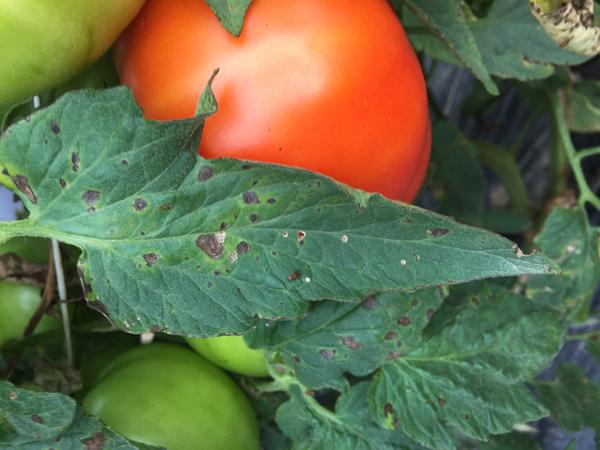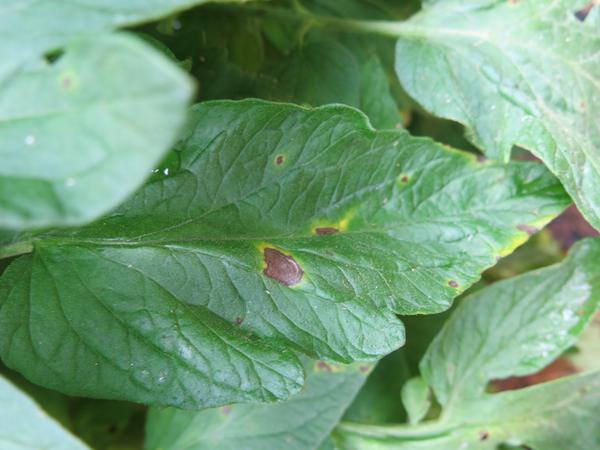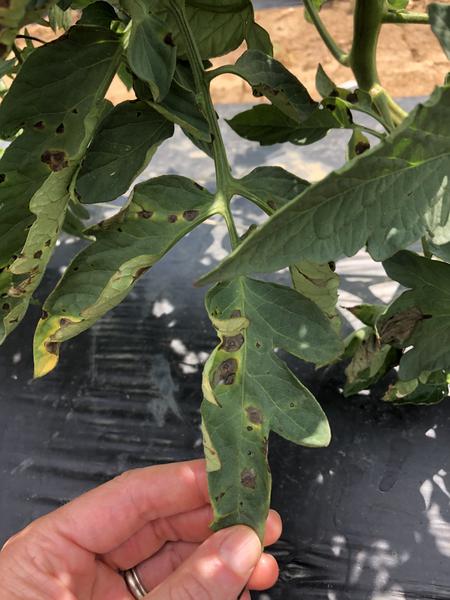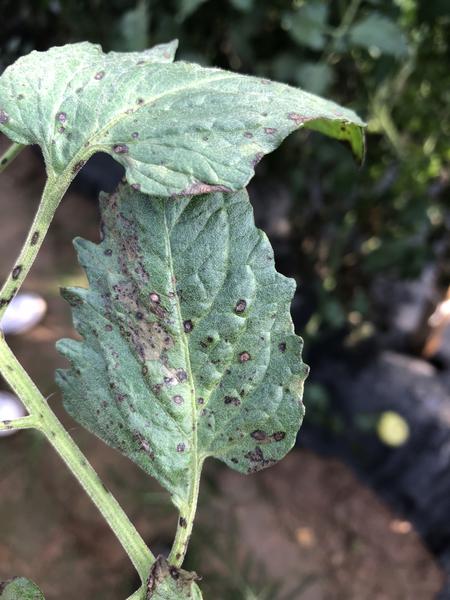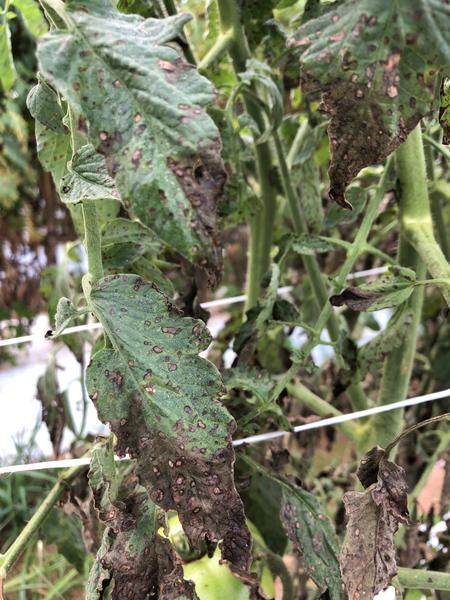Pathogen
Early blight of tomato is caused primarily by the fungus Alternaria linariae (=A. tomatophila; formerly known as A. solani), although other species of Alternaria may be isolated from lesions.
Host Crops and Plants
Tomato is the most agriculturally important crop known to be affected by Alternaria linariae, although other members of Solanaceae and members of other plant families (Cucurbitaceae, Scrophulariaceae) can be affected.
Host Parts Affected
The leaves, fruit, and stem may be affected by Alternaria linariae.
Identification
Symptoms of early blight can occur on the foliage, fruit, and stem at any stage of development. The disease is more commonly observed in the field, however, seedlings in the greenhouse can be affected by collar rot (also caused by species of Alternaria).
Lesions first develop on lower leaves as small, brownish-black spots which can expand to about 1⁄4 - 1⁄2-inch in diameter with characteristic concentric rings in the darkened area. The area surrounding the lesions may become yellow and, as disease progresses, the entire leaf may turn yellow. In later stages, lesions may appear in the upper leaves and defoliation may occur in the lower part of the plant leaving the fruit susceptible to sunscald.
Fruit may become infected through the calyx around the stem attachment and are susceptible in the green or red stage. Lesions can expand to cover the entire fruit and are typically sunken, leathery, and dark brown to black with concentric rings.
Spores may be abundant on lesions on any part of the plant.
Look alike diseases: Several fungal diseases occur on the foliage of tomato and can make identification difficult. Septoria leaf spot produces smaller lesions with tan or light gray centers. Gray leaf spot also produces smaller and lighter brown lesions than what you would see with early blight, and the center of the gray leaf spot lesions tend to crack. Also, most hybrid tomatoes have resistance to gray leaf spot; however, most, if not all, heirloom varieties lack this resistance. Late blight produces lighter tan colored lesions that typically have a light green halo. Late blight will occur all over the plant including young leaves, whereas early blight would be found primarily on the lower leaves. Bacterial spot also may be confused with early blight when the early blight lesions are young and small or when both are present. In general, bacterial spot will be smaller (~1/16 in), may be water-soaked on the underside of the leaf, and the center of the lesion may fall out.
Favorable Environmental Conditions for Disease
Disease is favored by warm temperatures (>80F) and moderate to heavy rainfall.
The fungus can survive between seasons on crop debris in the soil. Volunteer tomato plants also can be a primary source of inoculum.
Disease Transmission
Spores of Alternaria linariae are primarily spread by wind, air currents, and water splash. The fungus survives in plant debris in soil and, in milder climates, can survive on volunteer tomato plants.
General Disease Management
- Maintain plant vigor. Maintaining adequate fertilization and improving host vigor can reduce susceptibility to early blight.
- Remove volunteer weeds. Removing volunteer tomatoes can reduce disease as they can serve as an inoculum source.
- Rotate every 2-3 years. Rotating away from tomato can reduce inoculum density in a field.
- Apply fungicides preventatively.
- Plant tolerant varieties. There is no resistance to early blight, however, some varieties are more tolerant to the disease: 'Mountain Magic', 'Mountain Fresh Plus F1', 'Bush Celebrity Hybrid', 'Big Beef Hybrid', 'Celebrity Hybrid', 'Rutgers', 'Juliet F1', 'Tommy Toe', 'Old Brooks', or 'Cabernet F1'.
Disease Control for Conventional Growers
In addition to the cultural practices listed above, there are several products that are effective at controlling the disease. In general, apply on a 7-14 day interval except where the label specifies otherwise. For the latest fungicide recommendations for early blight, consult the Southeastern US Vegetable Crop Handbook.
Example products for control of early blight in tomato.
| Active Ingredient | Example Product | PHI (days) | FRAC Group |
|---|---|---|---|
| azoxystrobin + chlorothalonil | Quadris Opti | 0 | 11 + M |
| azoxystrobin + difenoconazole | Quadris Top | 0 | 11 + 3 |
| boscalid | Endura | 0 | 7 |
| chlorothalonil | Bravo | 0 | M |
| cyprodinil + fludioxinil | Switch | 0 | 9 + 12 |
| difenoconazole + benzovindiflupyr | Aprovia Top | 0 | 7 + 3 |
| difenoconazole + cyprodinil | Inspire Super | 0 | 3 + 9 |
| fenamidone | Reason | 14 | 11 |
| flutriafol | Rhyme | 0 | 3 |
| fluopyram + trifloxystrobin | Luna Sensation | 3 | 7 + 11 |
| fluopyram + pyrimethanil | Luna Tranquility | 1 | 7 + 9 |
| fluxaypyroxad + pyraclostrobin | Priaxor | 7 | 7 + 11 |
| mandipropamid + difenoconazole | Revus Top | 1 | 40 + 3 |
| penthiopyrad | Fontelis | 0 | 7 |
| pydiflumetofen + fludioxonil | Miravis Prime | 0 | 7 + 12 |
| pyrimethanil | Scala | 1 | 9 |
| strobilurinR | Quadris, Cabrio, Gem, Evito | 0 | 11 |
| R Resistance to this group of fungicides has been reported in North Carolina. | |||
Disease Control for Organic Growers
For organic control, the cultural control measures described above are the best means of control.
Some products are listed below, but consult the Organic Materials Review Institute (OMRI) for a complete list of approved products.
| Active Ingredient | Example Product |
|---|---|
| Bacillus amyloliquefaciens strain D747 | Double Nickel 55 |
| Bacillus mycoides isolate J | LifeGard WG |
| Bacillus pumilus strain QST 2808 | Sonata |
| Bacillus subtilius strain IAB/BS03 | AVIV |
| Bacillus subtilis strain QST 713 | Cease, Serenad ASO, Serenade Opti |
| extract of Reynoutria sachalinensis | Regalia |
| fixed copper | various |
| polyoxin D zinc salt | OSO 5%SC |
| potassium bicarbonate | Carb-O-Nator |
| Streptomyces lydicus WYEC 108 | Actinovate AG |
Disease Control for Home Gardeners
In addition to the cultural practices mentioned above, home gardeners may reduce disease by the following.
- Trellis tomatoes to increase air flow and to prevent spores splashing up from the soil.
- Use a mulch to prevent spores from splashing up onto plants.
- Prune the bottom most leaves as the plant grows. These leaves are usually more infected than the upper parts of the plant.
Additional Resources
- The NC State University Plant Disease and Insect Clinic provides diagnostics and control recommendations
- The NC State Extension Plant Pathology Portal provides information on crop disease management
- The Southeastern US Vegetable Crop Handbook provides information on vegetable disease management
- The USDA Fungus-Host Distributions Database provides information about reported hosts for plant pathogenic fungi and oomycetes
Publication date: Dec. 11, 2015
Reviewed/Revised: April 24, 2025
The use of brand names in this publication does not imply endorsement by NC State University or N.C. A&T State University of the products or services named nor discrimination against similar products or services not mentioned.
Recommendations for the use of agricultural chemicals are included in this publication as a convenience to the reader. The use of brand names and any mention or listing of commercial products or services in this publication does not imply endorsement by NC State University or N.C. A&T State University nor discrimination against similar products or services not mentioned. Individuals who use agricultural chemicals are responsible for ensuring that the intended use complies with current regulations and conforms to the product label. Be sure to obtain current information about usage regulations and examine a current product label before applying any chemical. For assistance, contact your local N.C. Cooperative Extension county center.
N.C. Cooperative Extension prohibits discrimination and harassment regardless of age, color, disability, family and marital status, gender identity, national origin, political beliefs, race, religion, sex (including pregnancy), sexual orientation and veteran status.

